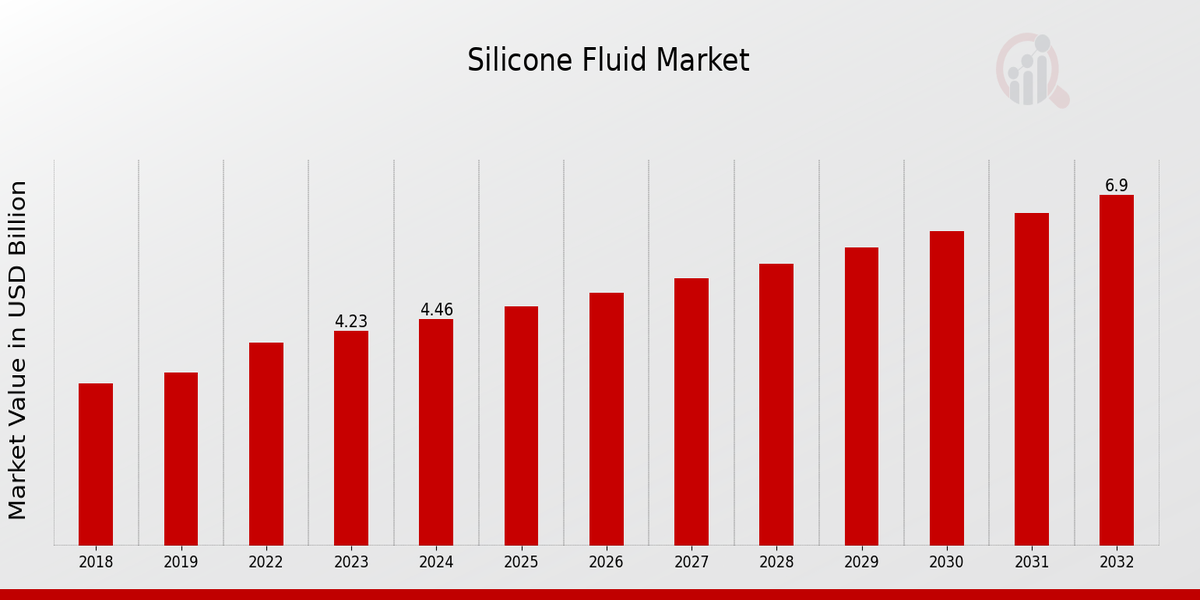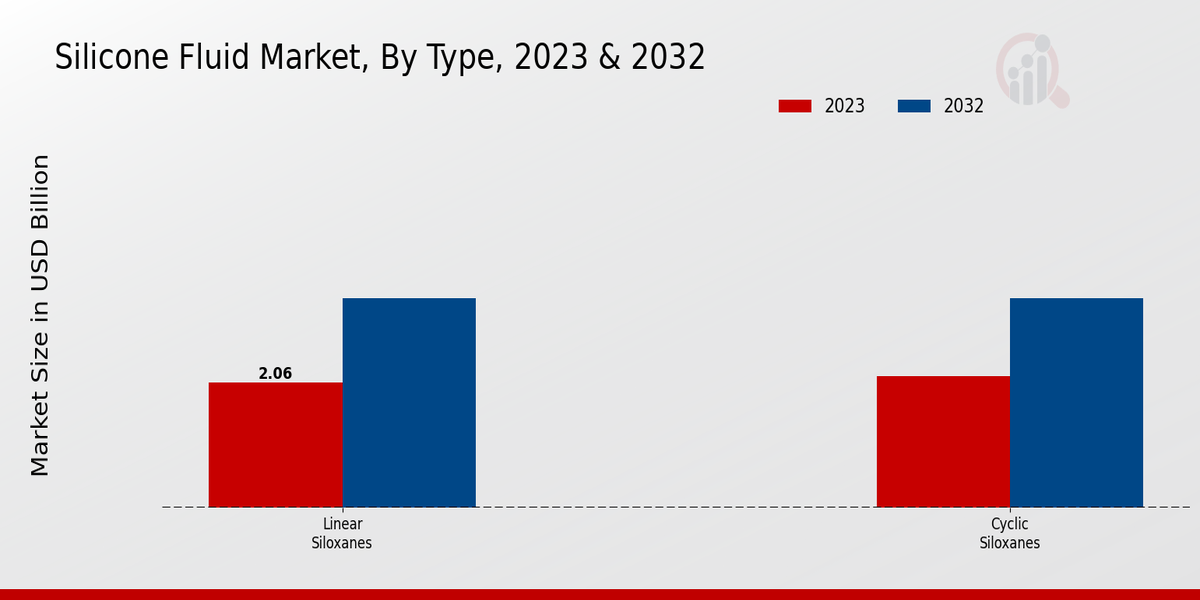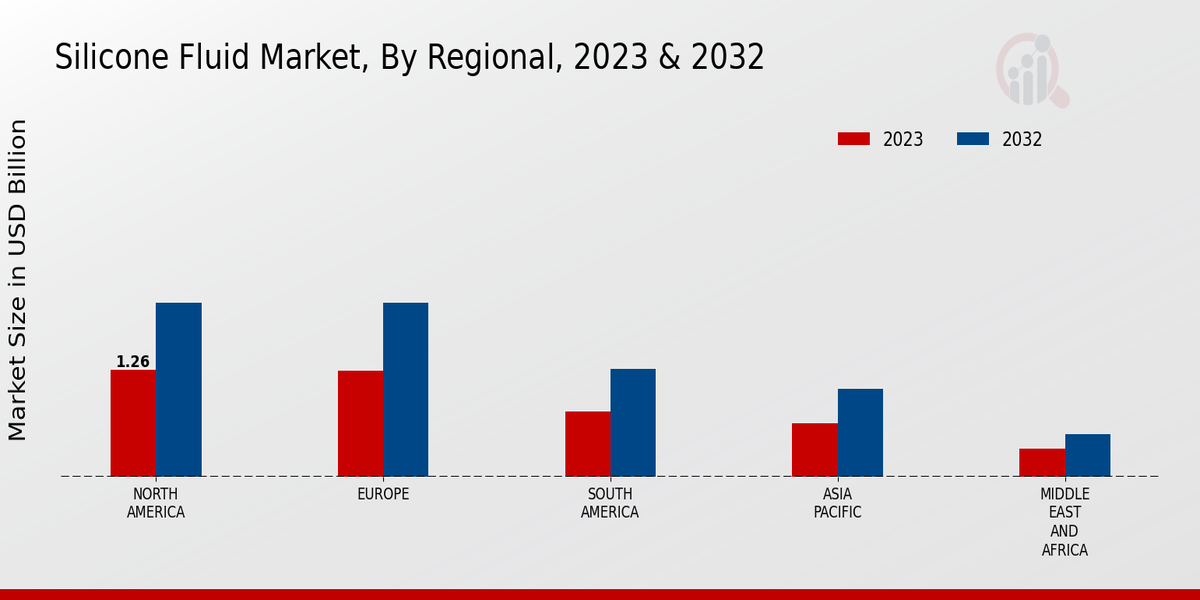Global Silicone Fluid Market Overview
The Silicone Fluid Market Size was estimated at 4.71 (USD Billion) in 2024. The Silicone Fluid Industry is expected to grow from 4.98 (USD Billion) in 2025 to 8.14 (USD Billion) by 2034. The Silicone Fluid Market CAGR (growth rate) is expected to be around 5.6% during the forecast period (2025 - 2034).
Key Silicone Fluid Market Trends Highlighted
Increasing demand from the automotive, electronics, and healthcare industries drives the Silicone Fluid Market. In automobiles, they are used in brake fluids, sealants, and lubricants, whereas in electronics, they are utilized for encapsulating and protecting sensitive components. Silicone fluids are employed in medical implants, drug delivery systems, and personal care products within the healthcare industry.
Opportunities in this market include the development of new applications in emerging markets such as Asia-Pacific and Latin America. Also, there is an expectation that increased adoption of electric vehicles and a growing healthcare sector would spur demand for silicone fluids.
Recent trends in this market have seen the development of new environmentally friendly products as well as increased integration of sensors and electronics into silicone fluids to enhance their functionality. These trends will continue into the future, thereby resulting in growth and Expansion of the silicone fluid market.

Source: Primary Research, Secondary Research, MRFR Database and Analyst Review
Silicone Fluid Market Drivers
Increasing Demand for Silicone Fluids in Electronics
The electronics industry is a major consumer of silicone fluids, primarily due to their unique properties, such as electrical insulation, thermal conductivity, and resistance to extreme temperatures. The growing demand for electronic devices, including smartphones, laptops, and wearable technologies, has led to a corresponding increase in the demand for silicone fluids. Silicone fluids are used in a variety of electronic applications, including as lubricants, sealants, and encapsulants.The increasing adoption of electronic devices in various sectors, such as automotive, healthcare, and consumer electronics, is expected to drive the growth of the silicone fluid market in the coming years.
Rising Adoption of Silicone Fluids in Personal Care and Cosmetics
Silicone fluids have gained significant popularity in the personal care and cosmetics industry due to their ability to enhance the sensory properties of products and provide various functional benefits. They are widely used in skincare, hair care, and color cosmetics applications. Silicone fluids impart a smooth, silky feel to products, reduce greasiness, and improve spread ability. Additionally, they act as emollients, helping to moisturize and protect the skin.The growing consumer preference for silicone-based personal care products, coupled with the increasing demand for anti-aging and skin care products, is expected to drive the growth of the silicone fluid market in the personal care and cosmetics segment.
Growing Use of Silicone Fluids in Industrial Applications
Silicone fluids are finding increasing applications in various industrial sectors, including automotive, aerospace, and construction. They are used as lubricants, release agents, and damping fluids in a wide range of industrial machinery and equipment. Silicone fluids offer advantages such as high-temperature stability, low volatility, and resistance to shear forces, making them suitable for demanding industrial applications. The growing demand for silicone fluids in industrial applications is expected to contribute to the overall growth of the Silicone Fluid Market Industry.
Silicone Fluid Market Segment Insights
Silicone Fluid Market Type Insights
The Silicone Fluid Market is segmented by type into linear and cyclic siloxanes. Linear Siloxanes: Linear siloxanes are the most common type of silicone fluid, and they are characterized by their long, chain-like structure. They are typically used in applications where low viscosity and high thermal stability are required, such as in personal care products, lubricants, and anti-foaming agents. They are typically used in applications where high-temperature stability and low volatility are required, such as in electronics, aerospace, and automotive applications.The market is also being driven by the growing demand for silicone fluids in emerging economies, such as China and India. The silicone fluid market is a competitive market, with a number of major players, such as Dow Corning, Momentive Performance Materials, and Wacker Chemie. These companies are investing heavily in research and development to develop new and innovative silicone fluid products.

Source: Primary Research, Secondary Research, MRFR Database and Analyst Review
Silicone Fluid Market Application Insights
The Silicone Fluid Market is segmented by application into personal care, automotive, industrial, electronics, and medical. The personal care segment is expected to account for the largest share of the market in 2023, owing to the increasing demand for silicone-based personal care products such as skin care creams, lotions, and hair care products. The automotive segment is expected to be the second-largest segment, driven by the rising demand for silicone fluids in automotive applications such as lubricants, sealants, and gaskets. The industrial segment is expected to grow at a steady pace, driven by the increasing use of silicone fluids in industrial applications such as paints, coatings, and adhesives.The electronics segment is expected to witness significant growth, owing to the rising demand for silicone fluids in electronic applications such as encapsulants, coatings, and thermal management materials. The medical segment is expected to grow at a moderate pace, driven by the increasing demand for silicone fluids in medical applications such as implants, medical devices, and drug delivery systems.
Silicone Fluid Market Viscosity Insights
Due to increasing demand from the automotive and electronics industries, the high-viscosity segment is anticipated to experience the highest growth rate during the forecast period. In 2024, the high-viscosity segment is expected to account for nearly half of the silicone fluid market revenue. The medium viscosity segment is majorly driven by its growing adoption in the construction and personal care industries. The low viscosity segment has the potential to grow significantly owing to its increasing use in various applications such as lubricants, mold release agents, and antifoaming agents in the industrial sector.
Silicone Fluid Market Distribution Channels Insights
The distribution channels segment of the Silicone Fluid Market is categorized into online platforms, distributors, and direct sales. Online platforms are gaining traction due to their convenience and accessibility, enabling customers to purchase silicone fluids directly from manufacturers or e-commerce marketplaces. In 2023, the online platform segment accounted for around 18% of the Silicone Fluid Market revenue, and this share is anticipated to grow to approximately 22% by 2032, driven by the increasing adoption of e-commerce and digitalization in the chemical industry.Distributors play a crucial role in the Silicone Fluid Market, providing a bridge between manufacturers and end-users. They offer warehousing, logistics, and technical support, ensuring efficient distribution and customer satisfaction. The distributor segment held a dominant share of over 55% in 2023 and is projected to maintain its leading position throughout the forecast period. Direct sales involve manufacturers selling silicone fluids directly to end-users, allowing for personalized service and control over pricing and distribution. This segment is expected to witness steady growth, capturing around 25% of the Silicone Fluid Market revenue by 2032.The growth is attributed to the increasing demand for customized silicone fluids and the desire for direct relationships between manufacturers and end-users in various industries.
Silicone Fluid Market Regional Insights
The Silicone Fluid Market is segmented into North America, Europe, APAC, South America, and MEA. Among these regions, APAC is expected to witness the fastest growth over the forecast period. The growth in this region can be attributed to the increasing demand for silicone fluids in various industries such as automotive, electronics, and personal care. North America and Europe are mature markets for silicone fluids, and the growth in these regions is expected to be steady. South America and MEA are expected to witness moderate growth over the forecast period.The growth in these regions can be attributed to the increasing industrialization and urbanization. In 2023, the Silicone Fluid Market was valued at USD 4.23 billion. The market is expected to grow at a CAGR of 5.6% over the forecast period, reaching a value of USD 6.9 billion by 2032. The growth of the market is attributed to the increasing demand for silicone fluids in various industries such as automotive, electronics, personal care, and construction.

Source: Primary Research, Secondary Research, MRFR Database and Analyst Review
Silicone Fluid Market Key Players And Competitive Insights
Major players in the Silicone Fluid Market industry are constantly striving to maintain their competitive edge by investing in research and development, expanding their product offerings, and forging strategic partnerships. Leading Silicone Fluid Market players recognize the importance of innovation and are actively working on developing novel silicone fluid formulations with enhanced properties to cater to the evolving needs of customers. The Silicone Fluid Market development landscape is marked by a healthy mix of established players and emerging companies, creating a dynamic competitive environment.Dow, a prominent player in the Silicone Fluid Market, possesses a robust product portfolio encompassing a wide range of silicone fluids tailored to diverse industry applications. The company's focus on innovation has led to the development of specialty silicone fluids with unique characteristics, catering to specific customer requirements. Dow's global presence and established distribution network provide it with a competitive advantage in reaching customers worldwide.Another key player in the silicone fluid market is Shin-Etsu, which is known for its comprehensive range of silicone fluids and commitment to quality. The company's extensive manufacturing capabilities and stringent quality control measures ensure the consistent production of high-purity silicone fluids. Shin-Etsu's focus on customer service and technical support has garnered it a loyal customer base across various industries.
Key Companies in the Silicone Fluid Market Include
- Evonik
- ShinEtsu Chemical
- Wacker Metroark Chemicals
- BASF
- Bluestar Silicones
- Soujanya Silicon
- Wacker Chemie
- KCC
- Momentive Performance Materials
- Elkem
- Tokuyama
- Air Products and Chemicals
- Nippon Electrical Glass
- Gelest
- Dow
Silicone Fluid Market Industry Developments
The silicone fluid market is projected to reach a value of USD 8.14 billion by 2034, exhibiting a CAGR of 5.6% during the forecast period (2025-2034). Increasing demand from the personal care and cosmetics industry, owing to the growing popularity of silicone-based skincare products, is a key factor driving market growth. Additionally, rising demand for silicone fluids in the automotive sector, particularly for use in brake fluids, lubricants, and sealants, is contributing to market expansion. Furthermore, the growing adoption of silicone fluids in the electronics industry for applications such as thermal management and insulation is further propelling market growth.
Silicone Fluid Market Segmentation Insights
- Silicone Fluid Market Type Outlook
- Linear Siloxanes
- Cyclic Siloxanes
- Silicone Fluid Market Application Outlook
- Personal Care
- Automotive
- Industrial
- Electronics
- Medical
- Silicone Fluid Market Viscosity Outlook
- High Viscosity
- Medium Viscosity
- Low Viscosity
- Silicone Fluid Market Distribution Channels Outlook
- Online Platforms
- Distributors
- Direct Sales
| Report Attribute/Metric |
Details |
| Market Size 2024 |
4.71 (USD Billion) |
| Market Size 2025 |
4.98 (USD Billion) |
| Market Size 2034 |
8.14 (USD Billion) |
| Compound Annual Growth Rate (CAGR) |
5.6% (2025 - 2034) |
| Report Coverage |
Revenue Forecast, Competitive Landscape, Growth Factors, and Trends |
| Base Year |
2024 |
| Market Forecast Period |
2025 - 2034 |
| Historical Data |
2020 - 2024 |
| Market Forecast Units |
USD Billion |
| Key Companies Profiled |
Evonik, ShinEtsu Chemical, Wacker Metroark Chemicals, BASF, Bluestar Silicones, Soujanya Silicon, Wacker Chemie, KCC, Momentive Performance Materials, Elkem, Tokuyama, Air Products and Chemicals, Nippon Electrical Glass, Gelest, Dow. |
| Segments Covered |
Type, Application, Viscosity, Distribution Channels, Regional |
| Key Market Opportunities |
1 Rising demand for Personal Care Products2 Growing Adoption in Electronics Industries3 Increasing Use in Medical Applications4 Expansion in Construction Sector5 Environmental Regulations and Sustainability Initiatives |
| Key Market Dynamics |
Rising demand in personal care and cosmetics Growth in electronics industry Increasing use in automotive applications Growing adoption in medical devices Expansion of construction sector. |
| Countries Covered |
North America, Europe, APAC, South America, MEA |
Frequently Asked Questions (FAQ) :
The global Silicone Fluid Market was valued at 4.98 Billion USD in 2025 and is projected to reach 8.14 Billion USD by 2034, exhibiting a CAGR of 5.6% during the forecast period (2025-2034).
The growth of the Silicone Fluid Market is primarily driven by increasing demand from various end-use industries, including personal care and cosmetics, automotive, electronics, and construction. The rising consumer preference for silicone-based products due to their unique properties, such as high-temperature resistance, chemical stability, and biocompatibility, is also contributing to market growth.
Asia Pacific is expected to dominate the Silicone Fluid Market throughout the forecast period. The region's rapid industrialization and growing population are driving the demand for silicone-based products in various industries.
Some of the key players in the Silicone Fluid Market include Dow, Wacker Chemie AG, Shin-Etsu Chemical Co., Ltd., Momentive Performance Materials Inc., and Elkem ASA.
Silicone Fluid finds applications in a wide range of industries, including personal care and cosmetics, automotive, electronics, construction, and healthcare. In personal care, it is used in skincare products, hair care products, and cosmetics. In the automotive industry, it is used in brake fluids, lubricants, and sealants. In electronics, it is used in encapsulants, coatings, and thermal management materials. In construction, it is used in sealants, coatings, and adhesives.
The Silicone Fluid Market faces challenges such as the volatility in the prices of raw materials, environmental regulations, and intense competition from alternative materials. Additionally, the market is susceptible to economic downturns, which can impact demand for silicone-based products.
The Silicone Fluid Market is witnessing the emergence of new trends, such as the increasing demand for bio-based silicone fluids, the development of silicone fluids with improved performance properties, and the growing adoption of silicone fluids in sustainable applications.
The Silicone Fluid Market is expected to grow at a CAGR of 5.6% from 2025 to 2034.
Key factors driving the growth of the Silicone Fluid Market include rising demand from emerging economies, increasing use of silicone fluids in high-growth industries such as electronics and healthcare, and ongoing advancements in silicone fluid technology.
Potential opportunities in the Silicone Fluid Market include the development of new applications for silicone fluids, the Expansion of silicone fluid production capacity in emerging regions, and the growing adoption of silicone fluids in sustainable and eco-friendly applications.














